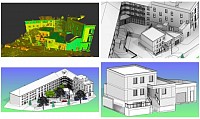How Scan To BIM and Point Cloud To BIM Processes are Connected
How Scan To BIM and Point Cloud To BIM Processes are Connected
Precision and accuracy are crucial in the world of architecture and construction. That's where technologies like Scan To BIM and Point Cloud To BIM come into play, revolutionizing how buildings are designed, analyzed, and renovated. But what exactly are these processes, and how are they connected?
Scan To BIM:
Scan-to-BIM, or Scan-to-Building Information Modeling, is a method for creating 3D models of buildings or structures using laser scanning technology. Laser scanners capture precise measurements of physical objects and spaces, generating a detailed point cloud. This point cloud data is then converted into a digital 3D model using specialized software. This digital standard contains details about the building's dimensions, layout, and structural elements.
Point Cloud To BIM :
Point Cloud To BIM takes the next step by converting the raw point cloud data into a Building Information Model (BIM). A point cloud is essentially a set of data points in a coordinate system, each representing a precise location in a three-dimensional space. This data is obtained from laser scans or photogrammetry and provides an accurate representation of the physical building or site.
Using specialized software, engineers, and architects can transform this dense point cloud data into a detailed BIM. This BIM includes not only geometric information but also additional details such as material specifications, structural components, MEP (mechanical, electrical, plumbing) systems, and other relevant data. This comprehensive digital representation serves as a valuable resource throughout the building's lifecycle, from design and construction to maintenance and renovation.
The Connection Between Scan To BIM and Point Cloud To BIM:
As a BIM modeller, understanding the intricate relationship between Scan To BIM (STB) and Point Cloud To BIM (PCTB) processes is crucial for effectively translating real-world structures into comprehensive digital models. Here’s a detailed look at how these processes interconnect and enhance our workflow:
1. Starting Point: Point Cloud Data
The journey begins with point cloud data, acquired through laser scanning or photogrammetry. This data captures millions of points in 3D space, meticulously mapping out the existing physical environment of a building or site. As BIM modellers, we receive this raw point cloud data, which serves as our primary reference for building the digital model.
2. Scan To BIM: Creating the Initial Model
In the Scan To BIM phase, our task is to convert the raw point cloud data into a preliminary digital model. This involves using software to interpret the point cloud and generate a basic 3D representation of the building’s geometry and spatial layout. Here, accuracy is paramount—we strive to faithfully replicate the real-world dimensions and configurations within the digital environment.
3. Refinement Through Point Cloud To BIM
Point Cloud To BIM builds upon the foundation laid by Scan To BIM. During this phase, we delve deeper into the point cloud data, refining our initial digital model to incorporate finer details and additional layers of information. This includes structural elements, architectural features, MEP systems, and other relevant components. The richness of the point cloud data allows us to achieve a higher level of detail and accuracy in our BIM model.
4. Iterative Process: Enhancing Accuracy and Completeness
The connection between Scan To BIM and Point Cloud To BIM is iterative and collaborative. We continuously iterate between these processes, leveraging the detailed point cloud data to validate and refine our BIM model. This iterative approach ensures that our digital representation not only meets but exceeds the accuracy of the physical structure, laying a solid foundation for downstream design, analysis, and construction activities.
5. Practical Applications in BIM Modelling
From a practical standpoint, integrating Scan To BIM and Point Cloud To BIM processes streamlines our workflow as BIM modellers. It enhances our ability to detect clashes, assess structural integrity, plan renovations, and optimize building performance—all based on a highly accurate digital twin of the physical asset. This digital twin serves as a comprehensive resource throughout the building’s lifecycle, supporting operations, maintenance, and future modifications.
6. Challenges and Opportunities
While the integration of Scan To BIM and Point Cloud To BIM offers substantial benefits, it also presents challenges such as managing large datasets, ensuring data consistency, and optimizing software interoperability. As BIM modellers, we embrace these challenges as opportunities for continuous improvement and innovation in our workflow.
About us:
In Silicon Valley, we specialize in providing BIM services worldwide, including Scan to BIM Services and Point Cloud to BIM services. We use advanced technology to transform detailed scans and point cloud data into comprehensive building models.
This helps improve accuracy and streamline collaboration among architects, engineers, and construction teams globally. Our responsibility to creation and exactness ensures that we deliver advanced digital solutions for construction projects everywhere.

